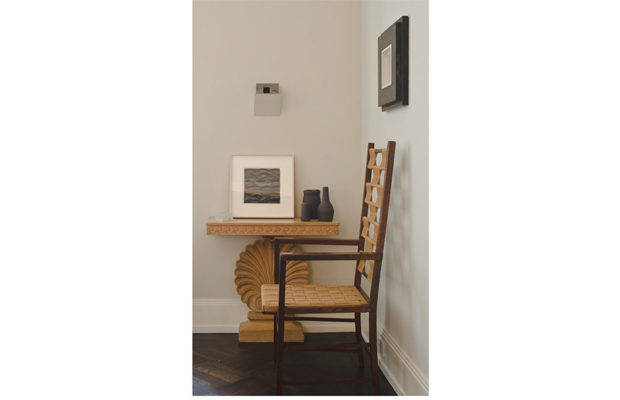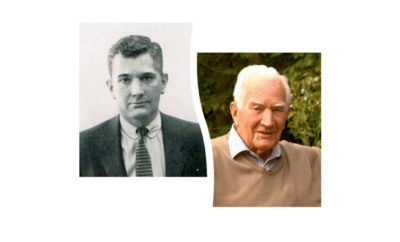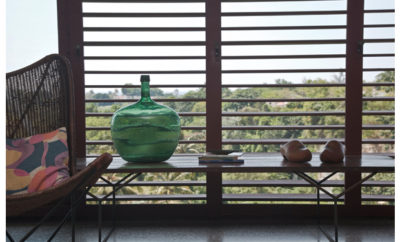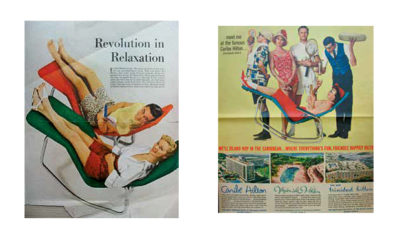
Feature
Perfect Composition

A wall piece by Jackie Winsor hangs above a rare Adolf Loos grass-back chair, one of a pair purchased at a design sale in London in the early 1990s. “Unfortunately it’s not original grass,” Douglas Baxter explains. “The chairs were completely falling apart. I wouldn’t have been able to afford them otherwise!” Beside it is an Edward Wormley carved pine console from the 1940s, also one of a pair.
Collecting blue chip art is something of an occupational hazard for Douglas Baxter. The president of New York’s Pace Gallery has helped nurture the careers of heavyweight artists such as Robert Mangold, Joel Shapiro, Elizabeth Murray, Donald Judd, and Sol LeWitt—and works by all of them feature prominently in Baxter’s Manhattan apartment. “Most of the pieces I own are by artists I know or have worked with,” he says. “I don’t think of them as my ‘collection’ so much as an extension of my personal and professional lives—the dividing line between them is not so black and white.”
That dividing line got even blurrier when Baxter relocated from the West Village to West Fifty-Seventh Street in an effort to shorten his commute. His search for a corner unit in an architecturally distinguished building led him to the Osborne, a legendary 1880s co-op that’s a favorite of well-heeled creative types (and just three blocks from the Pace Gallery). Although Baxter’s new apartment boasts high ceilings, a southern exposure, and graceful bones, its proportions were not sympathetic to his existing furnishings. So he shipped the majority to his Miami pied-à-terre and started fresh; among the few pieces he kept behind are a pair of rare Adolf Loos grass-back chairs, a bespoke Donald Judd platform bed, and twin Pierre Chareau bookcases.
A renovation overseen by designer Todd Klein re-jiggered the floor plan to showcase those prized possessions. It also restored the period glamour—in the form of parquet floors, classic moldings, and a tiled fireplace—that had been covered over by the previous tenant. Baxter even reinstated a doorway between the living room and the library, which had been walled off to form a second bedroom. The portal’s width was adjusted to create enough wall space to accommodate the Chareau bookcases, and to offer a straight-on view of the Judd bed from the living room. “Don designed that bed for my previous apartment,” Baxter explains. “The first design he drew up was too big. I said, ‘Don, I love it, but I don’t live in Marfa! I live in a little New York apartment!’ He ended up redoing it at about two-thirds scale.” Those proportions now work well in the library, allowing just enough extra room for a Frank Lloyd Wright desk, Carl André floor piece, and a Joe D’Urso lacquered cube table. (In the bedroom, Baxter now sleeps on a George Nakashima bed.)
Baxter’s redesign deliberately nods to the building’s quirky sensibility. “The Osborne has this great landmark lobby. The style is technically Renaissance revival, but it’s so over the top that the effect is arts and crafts,” he says. “In terms of the history of modernism, it’s quite interesting.” That offbeat Italianate grandeur sparked a series of like-minded acquisitions: a mirrored FontanaArte cupboard, a Murano-glass chandelier by Fred Wilson, Piero Fornasetti accents, and a pair of Ed Wormley shell-base consoles that “should be Italian,” Baxter says. “I love their goofiness. Those consoles completed the living room, making it look less like a gallery.” Their shallow depth, he adds, seemed tailor made for the space. “It’s as if I commissioned them, saying, ‘Ed, make me a little anchor for that corner that’ll liven up the place.’”
The consoles’ whimsical curves serve as a foil to the otherwise squared-off lines that dominate the room. A cubical Sol LeWitt construction is displayed on a Robert Mallet-Stevens table with a similarly shaped base. Perched nearby is a pair of René Gabriel armchairs whose gridded backs reiterate the boxy sofa and the caning of the Loos seats as well as a slatted bench by Harry Weese and a Judd wall box in plywood and plexiglass. “Most of my pieces are early-to-mid-twentieth century,” says Baxter. “But if something is geometric, I like it even if it’s eighteenth-century Chinese. It’s obvious that I like very architectural furniture.” And architectural art, too.
One of his primary concerns was that everything in the apartment be of-a-piece. “Collectors often choose furniture that competes with the art; I wanted these to be complementary.” Canny juxtapositions reveal that sensibility—as well as a flash of humor. “There’s this weird thing going on with the Loos chairs, a Jackie Winsor piece that’s recessed into the wall, and the Joel Shapiro above the Wormley console, which has a little doorway you look into,” he says. The common denominator? “They all have holes.”
In some cases these pairings are deliberate. Other times they are accidental, the happy result of things shifting around as new works come into Baxter’s life, get loaned out for exhibitions, or just need a little rest. “I never leave a blank space!” he says. Baxter enjoys opening up a dialogue between his artworks and his furniture. “As different as they are, they started talking to each other.” Ultimately, that’s what makes Baxter’s apartment, filled with some of the biggest names in art and design, read as a home and not a private gallery: his commitment to letting relationships between pieces—and his relationships to them—evolve over time.

The living room opens into the library through pocket doors. Squared-off forms prevail in the living room, including the 1940s French sofa (purchased at Amy Perlin Antiques), the pair of René Gabriel armchairs flanking the Robert Mallet-Stevens table and the Sol LeWitt sculpture on the table. “Othello’s Light,” the Murano-glass chandelier in the library, is by Fred Wilson.












